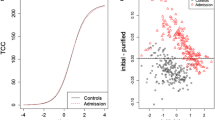Abstract
Since the Global Assessment of Functioning Scale (GAF) was introduced in DSM-III-R in 1987, it has been widely used, but minimally researched. This report provides information concerning the use of the GAF in routine clinical practice. Clinicians rated adult inpatients, adult day hospital patients, and adolescent inpatients at admission and discharge from psychiatric treatment. All samples were rated as significantly less dysfunctional at discharge. There were also significant differences in mean levels of dysfunction between the adult and adolescent samples at admission and discharge. These discrepancies were hypothesized to be associated with the GAF's unclear instructional format. Although this study concerned the GAF as described in the DSM-III-R, our findings are likely to be generalizable to DSM-IV, because no substantive changes have been made to the GAF.
Similar content being viewed by others
REFERENCES
American Psychiatric Association. (1987). Diagnostic and statistical manual of mental disorders (3rd ed., rev.). Washington, D.C.: Author.
American Psychiatric Association. (1994). Diagnostic and statistical manual of mental disorders (4th ed.). Washington, D.C.: Author.
Derogatis, L.R. (1992). The Brief Symptom Inventory (BSI): Administration, scoring and procedures manual—II. Baltimore: Johns Hopkins University School of Medicine, Clinical Psychometrics Research Unit.
Dufton, B.D., & Siddique, C.M. (1992). Measures in the day hospital. I. The Global Assessment of Functioning Scale. International Journal of Partial Hospitalization, 8, 41-49.
Goldman, H.H., Skodol, A.E., & Lave, T.R. (1992). Revising Axis V for DSM-IV: A review of measures of social functioning (Special Article). American Journal of Psychiatry, 149, 1148-1156.
Piersma, H. L., & Boes, J.L. (1994). Agreement between patient self-report and clinician rating: Concurrence between the BSI and the GAF among psychiatric inpatients. Manuscript submitted for publication.
Robinson, R.M., Powers, J.M., Cleveland, P.H., & Thyer, B.A. (1990). Inpatient psychiatric treatment for depressed children and adolescents: Preliminary evaluations. The Psychiatric Hospital, 21, 107-112.
Skodol, A.E., Link, B.G., Shrout, P.E., & Horwath, E. (1988). The revision of Axis V in DSM-III-R: Should symptoms have been included? American Journal of Psychiatry, 145, 825-829.
Warner, A. (1989). Utilizing Axis V (DSM-III-R) as a mental health treatment outcome measure. Unpublished manuscript. Department of Health and Fitness, Nova Scotia.
Williams, J.B.W., Gibbon, M., First, M.B., Spitzer, R.L., Davies, M., Borus, J., Howes, M.J., Kane, J., Pope, H.G., Rounsaville, B., & Wittchen, H. (1992). The Structured Clinical Interview for DSM-III-R (SCID): II. Multisite test-retest reliability. Archives of General Psychiatry, 49, 630-636.
Author information
Authors and Affiliations
Rights and permissions
About this article
Cite this article
Piersma, H.L., Boes, J.L. The GAF and Psychiatric Outcome: A Descriptive Report. Community Ment Health J 33, 35–41 (1997). https://doi.org/10.1023/A:1022413110345
Issue Date:
DOI: https://doi.org/10.1023/A:1022413110345



